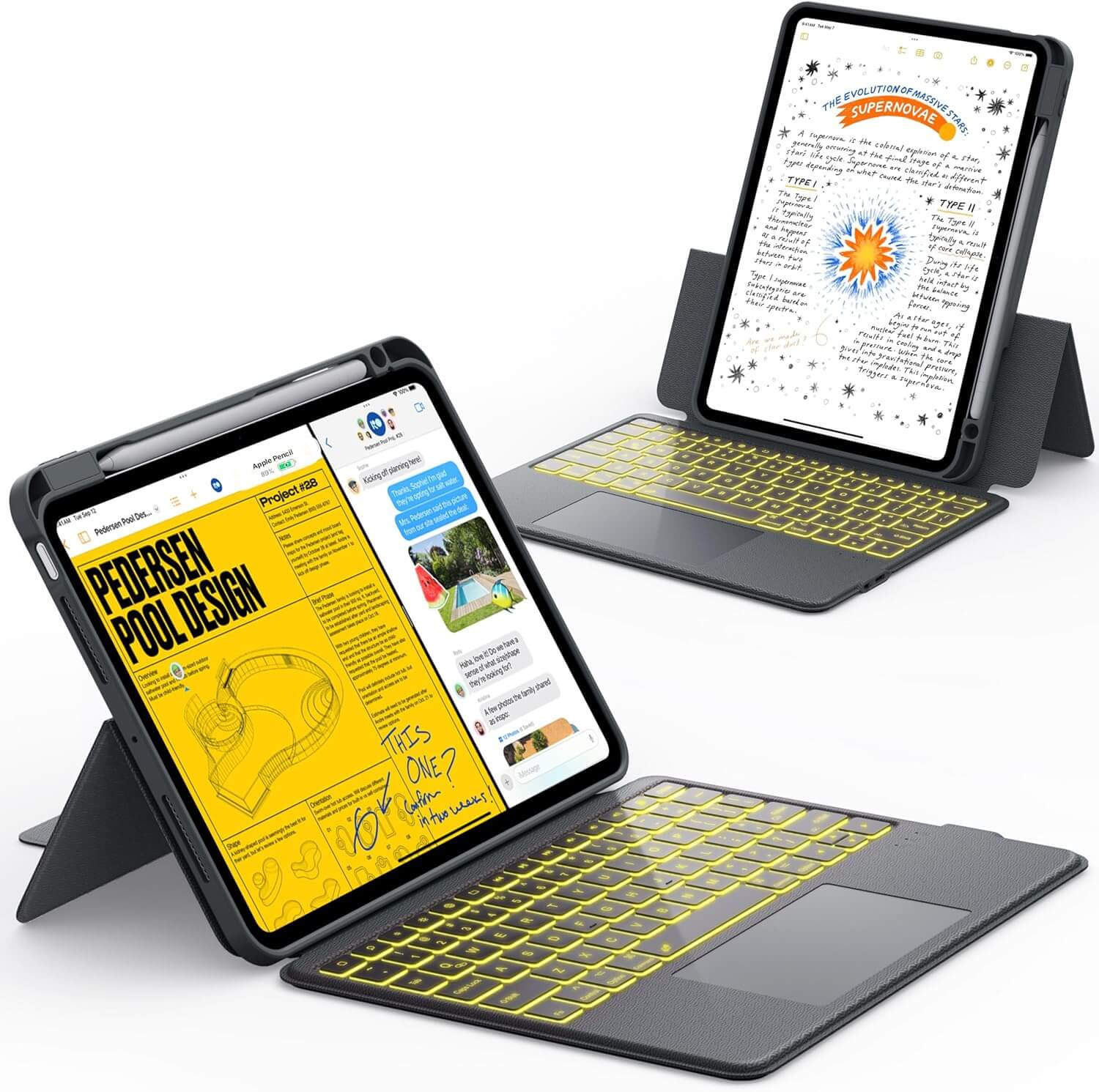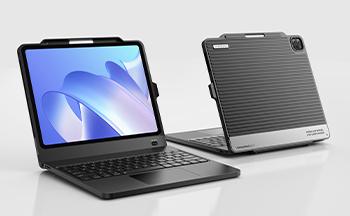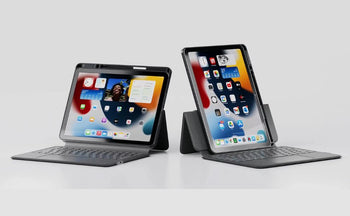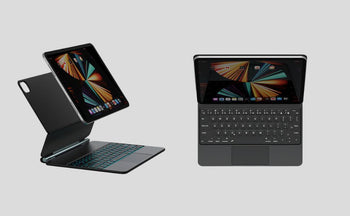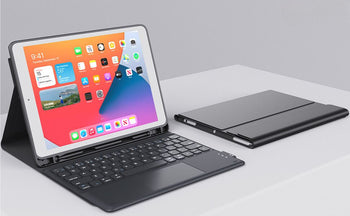Chromebook vs iPad is a common comparison for anyone choosing a device for school, work, or everyday use.
Chromebooks are known for being budget-friendly and great for typing-heavy tasks, while iPads shine with their app ecosystem, portability, and touchscreen experience. Each has its strengths, depending on how you plan to use it.
In this guide, we’ll break down how they compare performance, features, value, and more so you can decide which is better for students and professionals in 2025.
Understanding Chromebooks vs. iPads
Chromebooks and iPads are popular choices for portable devices, each offering unique features that cater to different needs.
While Chromebooks generally provide affordability and functionality for everyday tasks, iPads excel in performance and multimedia experiences.
What Is a Chromebook?
A Chromebook is a lightweight laptop or tablet that runs on ChromeOS, Google's cloud-focused operating system.
It’s designed for simplicity, speed, and value, especially in school or work environments that rely on web-based tools.
Key features of a Chromebook:
- Runs ChromeOS, built around the Chrome browser and cloud apps
- Supports Android apps from the Google Play Store
- Ideal for tasks like web browsing, word processing, and streaming
- Offers long battery life and fast startup times
- Typically more affordable than traditional laptops or tablets
- Popular in classrooms due to ease of use and centralized management
What Is an iPad?
An iPad is a tablet developed by Apple, running on iPadOS (a version of iOS). It’s known for its premium build quality, fast performance, and wide app selection from the App Store.
Key features of an iPad:
- Runs iPadOS with access to a large library of apps
- High-resolution display, ideal for reading, streaming, and creative work
- Compatible with the Apple Pencil for drawing, note-taking, and editing
- Great for media consumption and productivity on the go
- Seamless integration with other Apple devices and services
- It has a higher price point but offers a premium experience
Choosing between a Chromebook and an iPad depends on your needs, whether you’re using them for productivity, entertainment, or creative work.
📌 Also Read: 15 Features of Ipados 18 to Increase Your Efficiency
Chromebook vs iPad: Quick Comparison Table
|
Feature |
Chromebook |
iPad |
|
OS |
ChromeOS |
iPadOS |
|
Price Range |
Generally lower, more budget-friendly |
Often higher, premium options available |
|
Input Methods |
Physical keyboard, touchscreen |
Touchscreen, Apple Pencil compatible |
|
Best For |
Writing, browsing, light media tasks |
Creative apps, media, and diverse app usage |
|
App Availability |
Access to Google Play apps |
Access to App Store apps |
|
Battery Life |
Varies; many offer 10+ hours |
Often 10 hours or more |
|
Storage Options |
Cloud storage reliance, some models have local |
Various options, generally higher local |
|
Accessories |
Often includes USB ports, supports external drives |
Apple Pencil, Smart Keyboard |
|
Portability |
Lightweight, often more lightweight with keyboards |
Very portable, slim design |
Chromebooks are known for being affordable and suited for everyday computing. They excel in tasks like web browsing and writing.
iPads are great for creative tasks and are known for their performance in creative applications, supported by the Apple Pencil and various accessories.
They often outperform basic Chromebooks in terms of functionality beyond browsing and word processing.
Chromebook vs iPad: Key Differences Explained
When choosing between a Chromebook and an iPad, it’s important to compare the essentials: operating system, app compatibility, hardware, performance, battery life, and cost. Each device has strengths depending on how you plan to use it, whether it’s for school, work, or everyday tasks.
1. Operating System and Software Experience
-
Chromebooks run on ChromeOS, a web-based system designed for speed and simplicity. It’s excellent for cloud-based tasks and remote learning but relies heavily on an internet connection.
-
iPads use iPadOS, a touch-optimized system with robust multitasking features like Split View and Slide Over. It supports a wide range of creative, productivity, and entertainment apps and gets regular updates from Apple.
2. App Ecosystem and Compatibility
Chromebooks work best with Google Workspace tools like Docs, Sheets, and Slides. These are great for collaboration and cloud storage but limited for offline use.
iPads offer a broader range of apps, including creative tools like Procreate, Notability, and LumaFusion. They also excel in education and creative content thanks to the App Store’s variety.
Both devices support parental controls and educational apps, but iPads tend to offer more variety in creative and learning tools.
3. Hardware and Build Quality
-
Chromebooks often include a built-in keyboard and trackpad, making them more laptop-like out of the box. Build quality varies depending on the model.
-
iPads require separate purchases for accessories like keyboards and the Apple Pencil but offer higher-quality materials and sleek, portable designs.
-
iPads also feature high-resolution Retina displays, which typically outperform the 1080p screens found in most Chromebooks.
- Apple Pencil support gives the iPad a significant advantage in precision input for drawing and note-taking.
4. Performance and Multitasking
-
Chromebooks come with a range of processors, from basic to mid-tier, and are fine for browsing, writing, and streaming.
- iPads, especially the latest models with Apple’s M-series chips, deliver stronger performance for video editing, gaming, and digital art tasks.
Chromebooks support multitasking with multiple open windows, while iPads use a multitasking layout designed for touch, offering a different experience with less flexibility for some users.
5. Battery Life and Portability
Both devices offer long battery life, typically around 10 hours, depending on usage.
-
iPads are generally thinner and lighter, making them easier to carry.
-
Chromebooks charge quickly via USB-C, which can be more convenient than some older iPad charging setups, though newer iPads now also support USB-C.
6. Price and Long-Term Value
Chromebooks are typically more affordable and budget-friendly, which is why many schools choose them.
iPads cost more upfront and often require accessories for full functionality, but they hold their resale value well and tend to last longer with proper care.
When comparing overall value, be sure to include the total cost of keyboards, styluses, and storage upgrades.
Which Should You Choose: Chromebook or iPad?
Deciding between a Chromebook and an iPad depends on your individual needs. Each device has specific benefits based on different lifestyles or work habits.
Best for Students
A Chromebook is often the better choice for students, especially in school settings.
- Works well with tools like Google Classroom, Docs, and Slides
- Great for writing papers, taking notes, and attending virtual classes
- Supports parental controls and device management features
- More budget-friendly, making it accessible for most students and schools
Best for Business or Remote Work
For work tasks, especially in document-heavy or collaborative roles, Chromebooks offer practical advantages.
- Built-in keyboards for easier typing and long work sessions
- Strong multitasking capabilities with multiple windows and tabs
- VPN and Google Workspace support for secure, cloud-based work
- Easy integration with productivity tools like Gmail, Calendar, and Meet
Best for Artists, Creators, and Designers
The iPad is a top pick for creatives who need powerful tools on a portable device.
- Supports creative apps like Procreate, Adobe Fresco, and LumaFusion
- Compatible with the Apple Pencil, which offers precise pressure sensitivity
- Ideal for drawing, editing, and design work on the go
- High-resolution display and responsive touch controls enhance creative output
Best for Travel and Casual Use
For casual users or frequent travelers, the iPad offers convenience and versatility.
- Great for browsing, watching videos, reading, and light work
- Long battery life and offline app capabilities for use on flights or commutes
- Lightweight and compact, making it easy to pack and carry
- App variety allows for everything from entertainment to light productivity
A Chromebook is generally more suitable for students and work tasks, while the iPad excels in creativity, portability, and casual usage.
Before making a decision, evaluate your priorities, such as typing, drawing, video calls, or media consumption.
Hidden Dealbreakers Most Buyers Miss
You might miss some critical factors when choosing between a Chromebook and an iPad. Understanding these can help you make a better choice.
1. No Full Desktop Apps on iPad
You can't run full desktop apps like Photoshop or VS Code on an iPad. This might limit tasks requiring more complex software. In contrast, Chromebooks handle web-based apps well but may not satisfy all your productivity needs.
2. Offline Workflow Challenges with Chromebooks
Chromebooks excel online, but they struggle with offline tasks. If your work demands frequent offline access, this might be a deal-breaker.
3. Keyboard Ergonomics
Wondering about typing comfort? Lower-cost Chromebooks often have introductory keyboards, while the iPad's Magic Keyboard offers a better typing experience but at a higher price.
4. Software Support Cutoffs
iPads typically have longer software support compared to Chromebooks. This means iPads receive updates for a more extended period, making them last longer in terms of software reliability.
5. Accessory Costs
Buying add-ons for iPads, like keyboards and styluses, can quickly raise the total price. In some cases, this might make them as expensive as laptops.
6. Consider These Factors Carefully
- Full desktop app limitations on iPads
- Offline restrictions on Chromebooks
- Ergonomics: budget Chromebook keyboards vs. Magic Keyboard
- Longevity of software support
- Overall cost with accessories
These hidden aspects might help clarify your decision when purchasing a device.
📌 Also Read: Best iPad Keyboard Cases for Professionals
Final Verdict: Chromebook vs iPad: Which One Wins in 2025?
When choosing between a Chromebook and an iPad, the best option depends on how you plan to use it.
Chromebooks are great for students and budget-conscious users, offering solid performance, easy access to educational tools, and excellent value.
iPads are ideal for creatives and those looking for long-term use, thanks to their high-resolution displays, powerful creative apps, and long software support.
If you prefer an iPad, consider enhancing its functionality with a Chesona iPad and Tablet Keyboard Case to turn it into a portable workstation.
To make the right choice for you, focus on your primary needs, whether they’re school, work, creativity, or cost.
Frequently Asked Questions
Certain features can make a difference when choosing between a Chromebook and an iPad: app compatibility, internet connectivity, suitability for kids, parental controls, and development capabilities.
Can I run Microsoft Office on a Chromebook or iPad?
Yes, you can run Microsoft Office on both Chromebooks and iPads. On a Chromebook, you can use the web-based versions of Word, Excel, and PowerPoint through the browser. On an iPad, you can download the Microsoft Office apps from the App Store. Some advanced features may require a Microsoft 365 subscription on either device.
Do Chromebooks work without Wi-Fi?
Yes, Chromebooks can work without Wi-Fi for basic tasks. You can use offline features like Google Docs, Sheets, and Gmail if you’ve already set them up. Some apps and files must be downloaded ahead of time to access them offline. However, most Chromebooks work best when connected to the internet.
Which is better for kids under 12: Chrombooks or iPads?
For kids under 12, iPads are often better for creative learning and entertainment. They offer a wide range of kid-friendly apps, educational games, and touchscreen activities. iPads are also easier for younger kids to use with their simple interface. Chromebooks are better suited for older kids who need keyboard-based tasks and school-related tools.
Which has better parental control features: Chrombooks or iPads?
Chromebooks and iPads offer strong parental controls, but Chromebooks have an edge for school use. With Google Family Link, parents can easily manage screen time, app access, and account activity. iPads also have built-in parental controls through Screen Time, but managing devices across multiple users can be more complex. Chromebooks are often easier to manage for families using Google accounts.
Can I code or do development work on either Chrombooks or iPads?
You can do basic coding on Chromebooks and iPads, but Chromebooks are better for most development tasks. Chromebooks support web-based coding tools; some can run Linux for more advanced work. iPads are limited to app-based environments, which may not suit professional or complex coding needs. For learning to code, both work well, but Chromebooks offer more flexibility.
